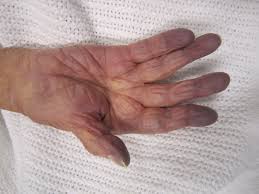cyanosis
英 [ˌsaɪə'nəʊsɪs]
美 [ˌsaɪə'noʊsɪs]
- n. 苍白病;黄萎病

记忆方法
为了记忆单词“cyanosis”,可以采用以下联想记忆法:
将“cyan”联想成“蓝色”(blue),因为“cyanosis”指的是一种皮肤和黏膜呈现蓝色的病理状态。可以想象一个人在寒冷或疾病状态下脸色呈现出类似蓝色的“icy”效果,即“icyosis”简化为“cyanosis”。通过这种视觉联想,单词“cyanosis”与“蓝色”和“冰冷的”特征联系起来,便于记忆。
将“cyan”联想成“蓝色”(blue),因为“cyanosis”指的是一种皮肤和黏膜呈现蓝色的病理状态。可以想象一个人在寒冷或疾病状态下脸色呈现出类似蓝色的“icy”效果,即“icyosis”简化为“cyanosis”。通过这种视觉联想,单词“cyanosis”与“蓝色”和“冰冷的”特征联系起来,便于记忆。
以上内容由AI生成, 仅供参考和借鉴
英语词源
- cyanosis (n.)
- "blue disease," the "blue jaundice" of the ancients, 1820, Medical Latin, from Greek kyanosis, from kyanos "dark blue color" (see cyan) + -osis.
权威例句
- 1. The patient has dyspnea, tachycardia, and cyanosis.
- 病人呼吸困难, 心动过数及发绀.
- 2. His extremities do not exhibit any clubbing, cyanosis, or edema.
- 四肢无杵状指, 发绀或水肿.
- 3. Central cyanosis makes a congenital cardiac disorder highly likely.
- 中央型发绀提示先天性心脏病的可能性极高.
- 4. Clinton's skin, you cannot see any jaundice or cyanosis.
- 再观察他的皮肤, 无黄疸和发绀.
- 5. The new born baby's cyanosis worried its parents very much.
- 新生婴儿发绀了,父母很着急.